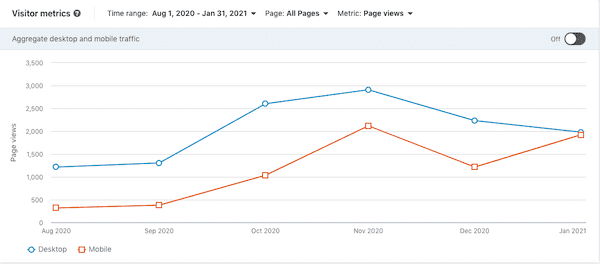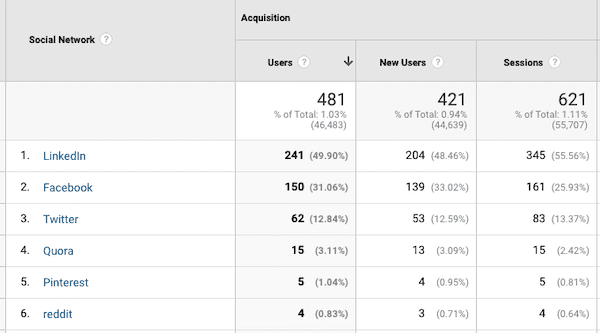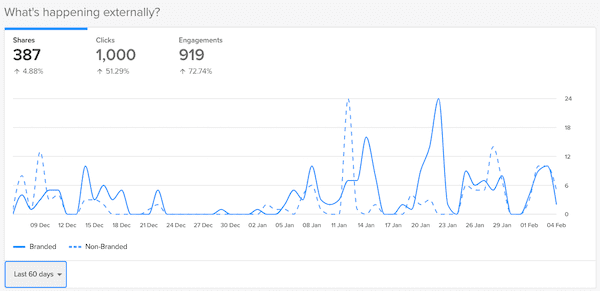There is no reason for me to dive into just how important social media is to businesses today. If you are on this post about social media KPIs, then the impact of being active on social networks is glaringly obvious.
But to truly understand the business value and showcase to your team, managers, or executives the results — you have to actively measure important KPIs that prove the true value.
As you may be well aware if you work in marketing, opinions are great, but it’s data and measurable numbers that you need to back up any claims you might be making.
So how do you choose which social media KPIs are right for you and what types of measurements your company should be tracking?
- What Is A Social Media KPI?
- Social Media KPIs for Engagement
- Social Media KPIs for Reach
- Social Media KPIs for Conversions
- Social Media KPIs for Customer Engagement
- Social Media KPIs for Employee Advocacy
What is a Social Media KPI?
A social media KPI (key performance indicator) is what your organization measures when it comes to campaigns and efforts on social media networks. It helps everyone understand what data you are monitoring and what metrics you are tracking to show how your social efforts positively impact business goals.
It’s pretty hard to tell if your content and various social campaigns are working without understanding the data and performance.
Nor do you know for sure if it’s helping your bottom-line or helping you make the right decisions when it comes to other social campaigns.
Oftentimes, the data you want to monitor on social media is ignored or your organization ends up not focusing on the right aspects. Generating and monitoring “likes” is one thing, but that is only one small social media KPI to track.
Social Media KPIs for Engagement
Driving authentic brand engagement is the fuel at the heart of every department in an organization, especially for social media. It’s also why we created a podcast around engagement, as it’s important to everything your business does.
And social media engagement is one of the best social media KPIs you can measure. Engagement entails quite a bit, but this is a cumulation of likes, shares, comments, etc.

Examples of social media KPIs for engagement:
- Social media clicks: How many clicks are coming from your social media posts? Are you seeing more clicks from LinkedIn than Twitter or Facebook? Keeping tabs on these results is super simple, but provides you insights into how audiences connect with your content. And the more quality traffic you drive from your social posts, the more potential conversions and sales you can achieve.
Tip: Make sure to monitor time on the page and bounce rate from your social traffic. If the time on site is quick and the bounce rate is high, your content and landing pages may need some help.
- Social media likes: When someone likes your post, it can be a good indication the material interests them. Now, it’s not necessarily the best metric from all we have in the lists here. But as you generate more “likes” on your posts, this can help more people gravitate towards it and help the content show up higher in people’s personal feeds.
- Comments on posts: Our team looks at comments as a strong indicator of quality over a “like,” as it takes someone more interest to actually type something out. Again, it’s not the best social media KPI to focus on, but something you should monitor. Starting conversations and responding to comments also helps your content get noticed and build relationships with audiences.
- Mentions of your brand: One of the best feelings as a marketer is seeing audiences and customers mentioning your brand and content in a positive way. Word of mouth marketing online is massive, and this shows you are building some brand awareness online. It may not lead to direct business revenue, but it’s impactful nonetheless.
- Post reshares: Similar to a “like” someone can easily just click and in 30 seconds the post is reshared or retweeted. While Twitter feeds move fast, typically on LinkedIn people are more thoughtful before resharing to their networks. So getting content reshares can be a sign that your content is interesting and informative that others want to share.
Social media KPIs for Reach
An interesting social media KPI to keep a close watch on is how far your message is traveling, or better known as your social reach.
How many people may have come across your content? Who is interacting with it? Understanding these points can help guide your social media strategies.
Examples of social media KPIs for reach:
- Follower count: The easiest metric to look at is your total social follower count on your various channels. You can easily generate followers through various services or means to look like a large brand. But if you have 10,000 social followers on LinkedIn and get 1 or 2 likes on a post, then you probably don’t have true fans and audiences that are interested in your brand and content. But as you organically grow this, it can help you determine your potential reach.
- Social impressions: Impressions are the number of times your posts have been shown on a newsfeed or a persons’ timeline. And one person can also have multiple impressions, which can skew your complete reach metrics a bit. But the higher you can get this number, the better overall impact for your brand as it means the social platforms think your content is great and it’s expanding your overall reach.
- Web traffic from social media: One of the more important reach metrics is how much website traffic your social posts are driving. It’s how you can convert social followers and those seeing your content into leads and potential customers. Pay attention to your social posts and the reach they are getting. If those numbers are high and looking good, but your web traffic is weak then it’s a good indication your website content or call to action isn’t intriguing enough.
- Share of voice: Your company will be fighting for attention on social media, especially against your various competitors. Share of Voice is a metric that focuses on how much attention your brand has compared to those of your competitors. You want to be at the top of your market and want more audiences to recognize you over the others. This can be a combo of monitoring conversations around your brand, seeing more mentions of your company, and industry leaders addressing your products or services more often.
Social Media KPIs for Conversions
Many social media KPIs may seem more like a “vanity metric,” meaning the numbers look awesome, but might not necessarily be impacting business objectives or revenue.
Although vanity metrics in social media do have their place, the KPIs that matter most from social networks are how they impact conversions.

Examples of social media KPIs for conversions:
- Lead funnel attribution: generating leads for your company is critical for marketing and sales, but not every lead will become revenue for you. But one social KPI worth monitoring is how many conversions are coming from your social media channels. Maybe that’s an eBook download, newsletter sign-up, or some other email capture. This can also help you determine if the leads are coming through that fit your target demographics and where you might need to pivot your social content.
- Social media conversion rates: you’ll probably be posting from many different social media channels, but it’s good to understand your conversion rates. This can be done in a few ways. One being total social traffic divided by the number of conversions from social. But you also want to look at how many of your social media leads end up buying your product or paying for your services too. Using Google Analytics, Salesforce, or other automation tools like HubSpot will help you understand these numbers. Always ensure you have proper tracking on your social posts!
- Revenue generated: One of the big reasons to utilize social media is to help your organization generate more sales and revenue. So naturally, this is an important social media KPI to monitor. The easy thing to do is monitor the leads that become customers from social media. Additionally, you can tie a general value to each customer that comes directly from social media.
Social Media KPIs for Customer Engagement
Not every brand will have a lot of customer volume on social media, but you should still be proactive in measuring KPIs around customer engagement on social media. Your goal is to build loyalty, provide educational content, and be fast for support.
- 71% of consumers who’ve had a good social media service experience with a brand are likely to recommend it to others. (Ambassador)
- 80% of companies online are under the impression that they deliver exceptional social media customer service, while only 8% of their customers say they agree. (Smart Insights)
When you understand how your social efforts impact your customers, you can improve customer advocacy, keep customers for the long-term, and minimize support frustrations. Your social accounts are a way for customers to engage and get help with any of their needs.
Customer social media KPIs to monitor:
- Customer response time on social media accounts. Your customer expects responses quickly, so the faster you acknowledge their comments toward you, the better.
- The number of issues resolved via social communications. Not only do you need to monitor the rate of acknowledgment, but how fast those issues get resolved and communicated back via social. The impact on your brand is huge!
- Monitor positive brand mentions and customer lifetime value. As your brand awareness grows, you want to monitor what customers and others are saying about your company. The messages should be positive, showing their passion for your company, product, or services. Improving this and the customer lifetime value is not easy, but social media can help facilitate this. Keep track of the messages you may get and the sentiment of them.
Social Media KPIs for Employee Advocacy
If you are running an employee advocacy program (ahem, you definitely should be!), there are various social media KPIs to monitor here, as well.
If you are familiar with the concept of employee advocacy, you’ll know that employees creating and sharing content is a significant reason for using a platform.
But while the benefits of social media marketing are a component, remember employee advocacy can impact your whole company — especially for recruiting, employer brand, driving employee engagement, and improving internal communications.
But staying on topic, if you use employee advocacy software for marketing and sales, you want to monitor results and metrics in a few ways.
First, utilize UTM tracking for your advocacy campaigns to see how employees are driving results for your company. From clicks to conversions to sales revenue, EveryoneSocial utilizes UTMs and Bitly integrations to ensure you can easily find that data in your analytics.

On the admin side of the reporting of EveryoneSocial, you’ll see additional data and reports on the following:
- Total Shares, clicks, engagements on social shares
- Total employee social reach
- What are the most popular posts?
- Which posts have the most shares?
- Which shares are generating the most clicks?
- Which shares are generating the most engagements?
- Which employees are sharing the most?
- Which employees are posting the most?
Interested in employee advocacy and seeing the impact EveryoneSocial can have on marketing, sales, and beyond? Schedule your personalized demo!
Choosing Your Most Important KPIs for Social Media
For most large brands, understanding many social media KPIs will be important to guide their strategy. However, not every metric was created equally. Some of the social KPIs have more value than others or may be more important to your company, specifically.
So if you do not want or need to track them all, then you’ll want to focus on the metrics that are generally most valuable to ALL businesses. These include:
- Web traffic referrals attributed to your social posts
- How much engagement your specific social posts receive
- Social conversions that are tied to revenue
- The amount of reach your posts and brand are receiving
- Organic follower growth and brand mentions on social
Again, you might have more specifics to look at and maybe certain KPIs above aren’t as interesting to you, but you should consistently ensure your social media presence impacts your business goals in a positive way.
















